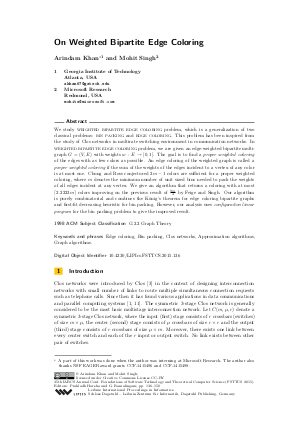On Weighted Bipartite Edge Coloring
Authors Arindam Khan, Mohit Singh
-
Part of:
Volume:
35th IARCS Annual Conference on Foundations of Software Technology and Theoretical Computer Science (FSTTCS 2015)
Part of: Series: Leibniz International Proceedings in Informatics (LIPIcs)
Part of: Conference: IARCS Annual Conference on Foundations of Software Technology and Theoretical Computer Science (FSTTCS) - License:
 Creative Commons Attribution 3.0 Unported license
Creative Commons Attribution 3.0 Unported license
- Publication Date: 2015-12-14
File

PDF
LIPIcs.FSTTCS.2015.136.pdf
- Filesize: 0.49 MB
- 15 pages
Document Identifiers
Subject Classification
Keywords
- Edge coloring
- Bin packing
- Clos networks
- Approximation algorithms
- Graph algorithms
Metrics
- Access Statistics
-
Total Accesses (updated on a weekly basis)
0Document
0Metadata
Abstract
We study weighted bipartite edge coloring problem, which is a generalization of two classical problems: bin packing and edge coloring. This problem has been inspired from the study of Clos networks in multirate switching environment in communication networks. In weighted bipartite edge coloring problem, we are given an edge-weighted bipartite multi-graph G=(V,E) with weights
w:E\rightarrow [0,1]. The goal is to find a proper
weighted coloring of the edges with as few colors as possible. An
edge coloring of the weighted graph is called a proper
weighted coloring if the sum of the weights of the edges incident
to a vertex of any color is at most one. Chung and Ross conjectured 2m-1 colors are sufficient for a proper weighted coloring, where m denotes the minimum number of unit sized bins needed to pack the weights of all edges incident at any vertex. We give an algorithm that returns a coloring with at most \lceil 2.2223m \rceil colors improving on the previous result of \frac{9m}{4} by Feige and Singh.
Our algorithm is purely combinatorial and combines the König's theorem for edge coloring bipartite graphs and first-fit decreasing heuristic for bin packing. However, our analysis uses configuration linear program for the bin packing problem to give the improved result.
Cite As Get BibTex
Arindam Khan and Mohit Singh. On Weighted Bipartite Edge Coloring. In 35th IARCS Annual Conference on Foundations of Software Technology and Theoretical Computer Science (FSTTCS 2015). Leibniz International Proceedings in Informatics (LIPIcs), Volume 45, pp. 136-150, Schloss Dagstuhl – Leibniz-Zentrum für Informatik (2015)
https://doi.org/10.4230/LIPIcs.FSTTCS.2015.136
BibTex
@InProceedings{khan_et_al:LIPIcs.FSTTCS.2015.136,
author = {Khan, Arindam and Singh, Mohit},
title = {{On Weighted Bipartite Edge Coloring}},
booktitle = {35th IARCS Annual Conference on Foundations of Software Technology and Theoretical Computer Science (FSTTCS 2015)},
pages = {136--150},
series = {Leibniz International Proceedings in Informatics (LIPIcs)},
ISBN = {978-3-939897-97-2},
ISSN = {1868-8969},
year = {2015},
volume = {45},
editor = {Harsha, Prahladh and Ramalingam, G.},
publisher = {Schloss Dagstuhl -- Leibniz-Zentrum f{\"u}r Informatik},
address = {Dagstuhl, Germany},
URL = {https://drops.dagstuhl.de/entities/document/10.4230/LIPIcs.FSTTCS.2015.136},
URN = {urn:nbn:de:0030-drops-56437},
doi = {10.4230/LIPIcs.FSTTCS.2015.136},
annote = {Keywords: Edge coloring, Bin packing, Clos networks, Approximation algorithms, Graph algorithms}
}
Author Details
References
-
John Beetem, Monty Denneau, and Don Weingarten. The gf11 supercomputer. In International Symposium on Computer architecture, pages 108-115, 1985.

-
Shun-Ping Chung and Keith W. Ross. On nonblocking multirate interconnection networks. SIAM Journal on Computing, 20(4):726-736, 1991.

-
C. Clos. A study of nonblocking switching networks. Bell System Technical Journal, 32(2):406-424, 1953.

-
Edward G. Coffman Jr, János Csirik, Gábor Galambos, Silvano Martello, and Daniele Vigo. Bin packing approximation algorithms: survey and classification. In Handbook of Combinatorial Optimization, pages 455-531. Springer, 2013.

-
J. Correa and M. X. Goemans. Improved bounds on nonblocking 3-stage clos networks. SIAM Journal of Computing, 37:870-894, 2007.

-
D. Z. Du, B. Gao, F. K. Hwang, and J. H. Kim. On multirate rearrangeable clos networks. SIAM Journal of Computing, 28(2):463-470, 1999.

-
Uriel Feige and Mohit Singh. Edge coloring and decompositions of weighted graphs. In ESA, pages 405-416, 2008.

-
Michael R. Garey, Ronald L. Graham, and Jeffrey D. Ullman. Worst-case analysis of memory allocation algorithms. In STOC, pages 143-150. ACM, 1972.

-
Rebecca Hoberg and Thomas Rothvoß. A logarithmic additive integrality gap for bin packing. CoRR, abs/1503.08796, 2015.

-
Ian Holyer. The NP-completeness of edge-coloring. SIAM Journal on Computing, 10(4):718-720, 1981.

-
A. Itoh, W. Takahashi, H. Nagano, M. Kurisaka, and S. Iwasaki. Practical implementation and packaging technologies for a large-scale atm switching system. Journal of Selected Areas in Communications, 9:1280-1288, 1991.

-
Narendra Karmarkar and Richard M Karp. An efficient approximation scheme for the one-dimensional bin-packing problem. In FOCS, pages 312-320. IEEE, 1982.

-
Arindam Khan. Approximation Algorithms for Multidimensional Bin Packing. PhD thesis, Georgia Institute of Technology, Atlanta, 2015.

-
D. König. Graphok és alkalmazásuk a determinánsok és a halmazok elméletére. Mathematikai és Természettudományi Ertesito, 34:104-119, 1916.

-
Riccardo Melen and Jonathan S. Turner. Nonblocking multirate distribution networks. IEEE Transactions on Communications, 41(2):362-369, 1993.

-
Hung Q. Ngo and Van H. Vu. Multirate rearrangeable clos networks and a generalized edge-coloring problem on bipartite graphs. SIAM J. Comput., 32(4):1040-1049, 2003.

-
Thomas Rothvoß. Approximating bin packing within o(log opt * log log opt) bins. In FOCS, pages 20-29, 2013.

-
Claude E. Shannon. A theorem on coloring the lines of a network. Journal of Mathematics and Physics, 28(2):148-151, 1949.

-
T. D. Slepian. Two theorems on a particular crossbar switching. unpublished manuscript, 1958.

-
Michael Stiebitz, Diego Scheide, Bjarne Toft, and Lene M. Favrholdt. Graph Edge Coloring: Vizing’s Theorem and Goldberg’s Conjecture, volume 75. John Wiley & Sons, 2012.

-
Peter Guthrie Tait. Remarks on the colouring of maps. Proc. Roy. Soc. Edinburgh, 10(729):501-503, 1880.

-
V. G. Vizing. On an estimate of the chromatic class of a p-graph (in russian). Diskret. Analiz, 3:23-30, 1964.

